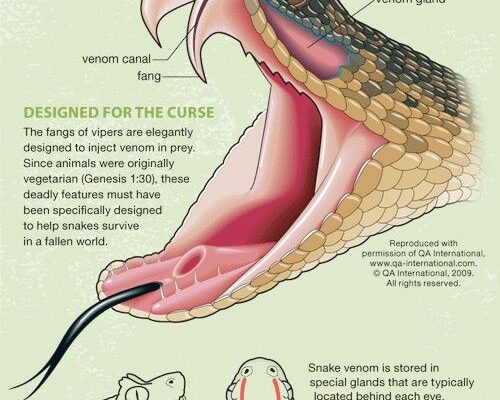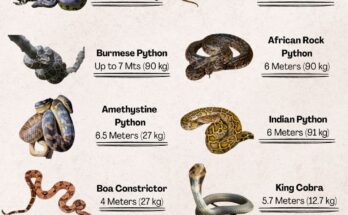The Intricate Design of Viper Fangs: A Marvel of Nature
The venomous fangs of vipers are a remarkable example of evolutionary adaptation, perfectly engineered for survival in a challenging world. This detailed exploration, based on the insightful chart titled “Designed for the Curse,” delves into the anatomy and functionality of viper fangs, shedding light on how these structures enable these snakes to thrive as predators. Created with permission from QA International and featured here, this educational resource offers a fascinating look at the biological mechanisms behind one of nature’s most potent weapons.

Anatomy of the Viper Fang
The chart provides a close-up view of a viper’s open mouth, highlighting the key components of its venom delivery system. The fang, a hollow, needle-like structure, is prominently displayed at the front of the upper jaw. This fang is connected to a venom canal, a specialized tube that channels venom from the venom gland—located behind the eye—directly to the tip of the fang. The venom-conducting tube ensures a seamless flow, allowing the snake to inject venom efficiently into its prey. The diagram illustrates this process with labeled sections, showing how the venom gland stores the toxin, which is then released through the fang during a bite. This intricate system is a testament to the precision of natural design, enabling vipers to subdue prey with remarkable effectiveness.
Evolutionary Purpose and Functionality
The text accompanying the chart explains that the fangs of vipers are elegantly designed to inject venom in prey. This adaptation is particularly significant given the original vegetarian nature of animals, as noted in Genesis 1:30, suggesting that such deadly features must have emerged post-fall to aid snake survival in a now-predatory world. When a viper strikes, the fangs, which are hinged and can fold against the roof of the mouth when not in use, extend forward to penetrate the prey. The venom, a complex cocktail of proteins and enzymes, immobilizes and begins digesting the victim, providing the snake with a critical advantage in securing food. This mechanism is especially vital for vipers, which rely on ambush tactics rather than pursuit, making the efficiency of their venom delivery system a matter of life and death.
Venom Storage and Control
A secondary diagram complements the main illustration by showing the placement of venom glands in relation to the snake’s head. These glands, depicted as red ovals located behind each eye, are specialized structures that store venom. The chart notes that when needed, the venom flows down a tube to the fang, where it is ejected. What sets vipers apart is their ability to control the amount of venom released, a process finely tuned based on the size of the intended prey. This regulatory capability minimizes waste and maximizes the snake’s chances of a successful hunt, whether targeting a small rodent or a larger animal. The precision of this control mechanism underscores the sophistication of viper physiology, adapted over millions of years to ensure survival.
Ecological and Biological Significance
Vipers, including species like rattlesnakes and pit vipers, inhabit diverse environments worldwide, from deserts to rainforests. Their fangs and venom systems are critical to their role as apex predators within these ecosystems, helping to regulate prey populations. The chart’s emphasis on the “curse” reflects a perspective that views these adaptations as a response to a fallen world, where predation became necessary for survival. This biological marvel not only fascinates herpetologists but also serves as a reminder of the complex interplay between anatomy, behavior, and environment in the animal kingdom.
Educational Value and Safety Insights
This resource, reproduced with permission from QA International (www.qa-international.com, © 2003, All rights reserved), is an invaluable tool for educators, students, and wildlife enthusiasts. It provides a clear visual and textual explanation of how viper fangs function, enhancing understanding of these creatures’ predatory nature. For those encountering vipers in the wild, the chart implicitly underscores the importance of caution—vipers strike with speed and precision, and their venom can be lethal to humans without prompt medical intervention. Awareness of their fang anatomy can aid in respecting their space and seeking help if bitten.
Image Credit: Reproduced with permission from QA International, © 2003, All rights reserved
Date: July 12, 2025, 12:57 PM EDT



